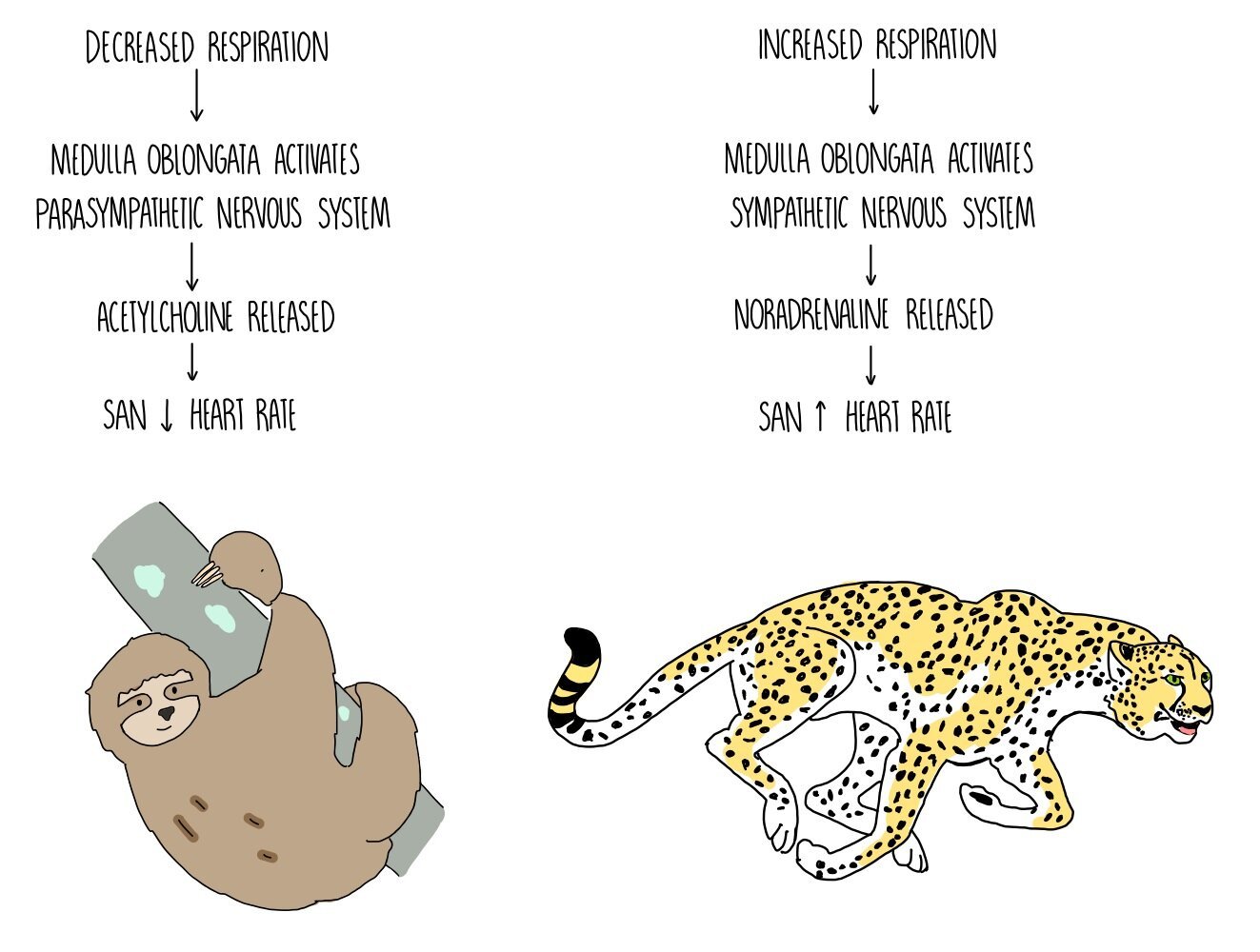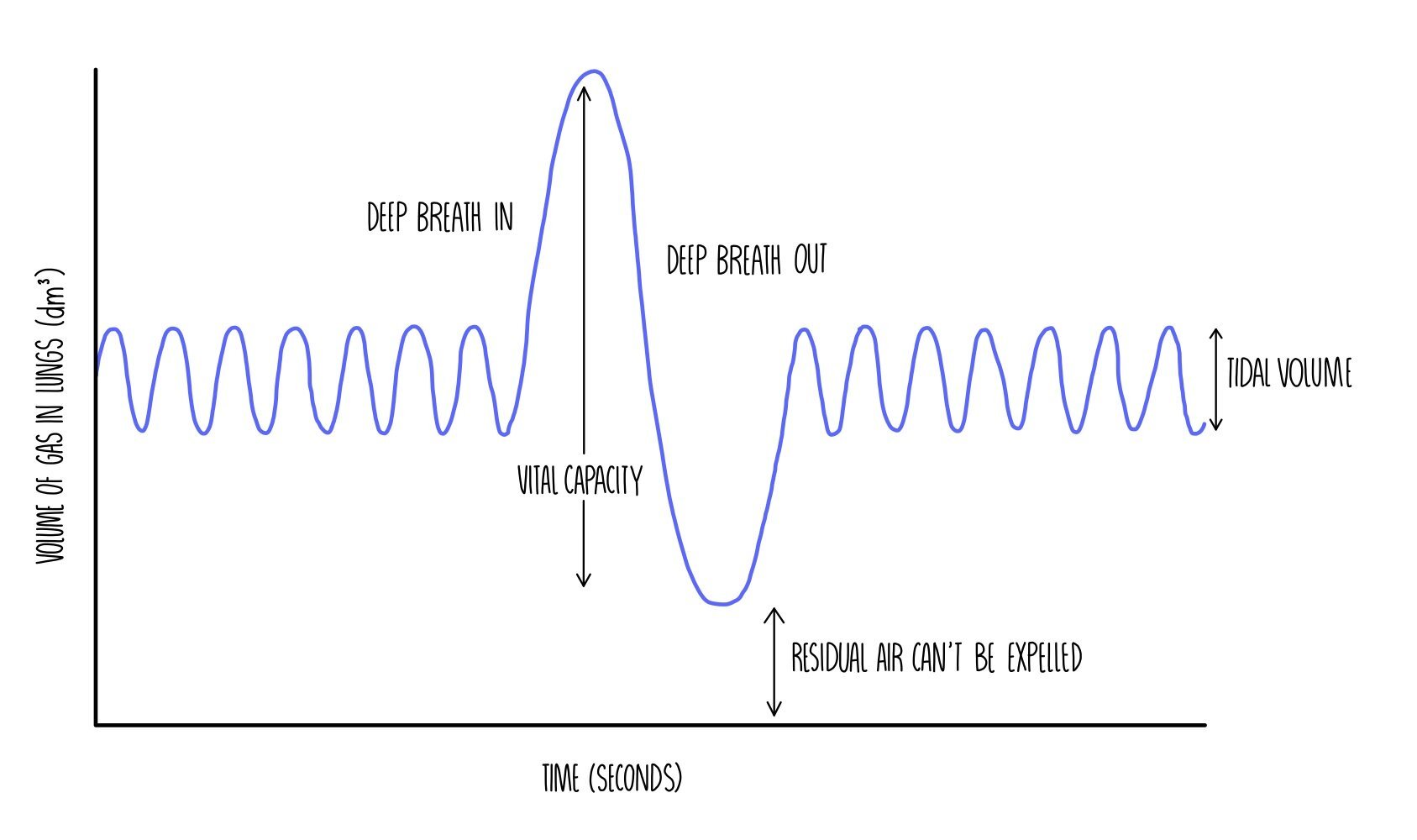Exercise
Effect of exercise on heart rate and breathing rate
When you exercise, your skeletal muscle is contracting quickly and frequently. This requires energy from respiration. To ensure that muscle cells have plenty of oxygen and glucose for respiration, heart rate increases to pump these substances around the body quicker. An increased heart rate also ensures the faster removal of the waste products of respiration (carbon dioxide). During exercise, our breathing rate also increases and we take deeper breaths. This results in getting a larger amount of oxygen into our body, as well as getting rid of the increased amount of carbon dioxide being produced.
Control of heart rate
The medulla oblongata is a brain region found at the bottom of the brain, in the brain stem. It is involved in unconscious processes, such as controlling heart rate and breathing rate. A part of the medulla oblongata called the cardiovascular control centre is responsible for changing heart rate according to our body’s needs. It works by sending impulses along sympathetic or parasympathetic neurones which release different neurotransmitters onto the SAN - the SAN then modifies its rate of firing to slow down or speed up the heart rate.
Two types of receptors, baroreceptors (pressure receptors) and chemoreceptors (chemical receptors) are responsible for detecting stimuli in the blood and signalling to the medulla oblongata to modify our heart rate. Baroreceptors detect changes in blood pressure and are found in the aortic and carotid bodies. Chemoreceptors detect the concentration of oxygen in the blood. They are also sensitive to changes in pH resulting from the carbon dioxide dissolved in the blood (its reacts with the water to form carbonic acid), which is an indication of oxygen availability. Chemoreceptors are also located in the aortic and carotid bodies.
When the medulla oblongata receives signals from baroreceptors and chemoreceptors, it changes the rate at which the sino-atrial node (SAN) fires. If blood pressure or oxygen concentration is low, the cardiovascular control centre increases the rate of SAN firing through activation of the sympathetic nervous system. The sympathetic nervous system is involved in the ‘fight and flight’ response and increases heart rate through the release of a neurotransmitter called noradrenaline, which binds to receptors on the SAN. On the other hand, high blood pressure and high oxygen concentration causes the cardiovascular control centre to reduce the rate of SAN firing by activating the parasympathetic nervous system. This is involved in the ‘rest and digest’ response and decreases heart rate through the release of another neurotransmitter called acetylcholine. Acetylcholine binds to receptors on the SAN to slow down its rate of firing.
Cardiac Output
Cardiac output is the total volume of blood pumped by a ventricle every minute. The larger the heart, and the more forceful the contractions, the larger the cardiac output. Cardiac output depends on stroke volume, which is the volume of blood pumped by one ventricle each time it contracts. You can calculate cardiac output by multiplying heart rate with stroke volume:
Control of breathing rate
Another part of the medulla oblongata, called the ventilation centres, are responsible for the control of breathing rate. There are two ventilation centres, the inspiratory centre (which is involved in breathing in) and the expiratory centre (which is involved in breathing out). When we are breathing in, a nerve impulse passes from the inspiratory centre to stimulate the intercostal and diaphragm muscles, causing them to contract. The diaphragm moves downwards and the ribcage moves upwards, increasing the volume in the lungs. This decreases the pressure. Air moves down a pressure gradient from the air outside our bodies into our lungs. Whenever the inspiratory centre is activated, it sends nerve impulses to the expiratory centre which inhibit it.
As air enters the lungs, stretch receptors in the lungs are activated. The activation of stretch receptors generates a nerve impulse which travels to the inspiratory centre to inhibit it. The inspiratory centre is no longer active, so it cannot inhibit the expiratory centre. The expiratory centre becomes activated and signals (through nerve impulses) to the intercostal and diaphragm muscles, causing them to relax. The diaphragm returns to a dome-shape and the ribcage moves downwards, reducing the volume in the thorax and increasing the pressure. Air is forced out of the lungs down a pressure gradient. As the lungs deflate, the stretch receptors in the lungs become inactive. The stretch receptors stop inhibiting the inspiratory centre, which becomes active, allowing the cycle of breathing to start again.
Role of chemoreceptors in increasing breathing rate
When we exercise, respiration increases so more carbon dioxide is produced. Carbon dioxide dissolves in the blood to form a weakly acidic solution (carbonic acid). The slight decrease in pH that occurs during exercise is detected by special receptors which can detect the presence of chemicals, called chemoreceptors. Chemoreceptors are found in the medulla oblongata, in aortic bodies and in carotid bodies (aortic and carotid bodies are clusters of cells located in the aorta and carotid artery respectively). When blood pH drops, the chemoreceptors are activated and send a nerve impulse to the medulla oblongata. The ventilation centres in the medulla oblongata respond by increasing the frequency of nerve impulses sent to the diaphragm and intercostal muscles. The diaphragm and intercostal muscles contract and relax faster, increasing the rate of breathing.
Investigating ventilation
You can investigate the volume of air that an individual is capable of breathing in and out using a piece of equipment called a spirometer. A spirometer consists of a chamber filled with oxygen and has a lid which moves up and down as a person breathes in and out. The spirometer is attached to a pen, which moves whenever the lid moves to draw a spirometer trace. A spirometer trace can be used to find the following information:
Tidal volume - this is the volume of air in each breath
Vital capacity - the maximum volume of air that a person can expel from the lungs after a maximum inhalation
It can also be used to calculate the following:
Breathing rate - the number of breaths taken per minute
Oxygen consumption - the volume of oxygen used by the body
Respiratory minute ventilation - the volume of gas breathed in and out in one minute. It is calculated by multiplying tidal volume by breathing rate, as shown in the equation below:
Spirometers contain a chemical called soda lime which absorbs any carbon dioxide that is breathed out. This means that the volume of gas in the chamber decreases as it is being used, since the oxygen in the chamber will be consumed by the person and the carbon dioxide that they exhale will be absorbed by the soda lime. Every time the spirometer is reused, the apparatus needs to be refilled with air.
Repairing sports-related injuries with surgery
Serious injuries can be fairly common when playing sports due to the fact that the body is being put under a lot of stress, for example, the knees takes a lot of impact during running. Advances in medical procedures, such as keyhole surgery, can help sportspeople recover more quickly from sports-related injuries. Keyhole surgery is a technique in which only a small incision is made in the skin. Surgeons can insert a camera and medical equipment through the tiny cut and repair the damaged part of the body. A common sports-related injury which can be repaired by keyhole surgery is damage to the cruciate ligament in the knee.
The advantages of keyhole surgery over normal surgery is that, due to the smaller incision, the patient is in less pain and recovers much faster from the surgery. The patients lose less blood from the incision and have less scarring after the procedure. This results in a shorter hospital stay for the patient and means that they can get back to playing sports sooner.
Prostheses
A prosthesis is an artificial limb which is used to replace a damaged or missing body part, allowing people with disabilities to participate in sport. Some prostheses are used to replace whole limbs (such as an artificial leg) or parts of a limb (such as a hip replacement). Other prostheses can be connected to an electronic device which is able to pick up information from the nervous system. For example, artificial hand prostheses which are connected to an electronic device can allow the person to move the fingers just by thinking.
Performance-enhancing drugs
Performance-enhancing drugs are drugs which are sometimes used in competitive sport to improve performance. They are banned in most sports and competitions will usually drug-test athletes to reduce their use. Any sportsperson who is found to have these drugs in their system can be banned from the sport and have medals and prizes taken away from them. There are different types of performance-enhancing drugs:
Anabolic steroids - these are drugs which help your body to produce muscle, increasing strength, speed and stamina of the athlete. They can also make people feel more aggressive.
Stimulants - these drugs increase reaction time and make people feel more alert. They also have the side-effect of increasing aggression.
Narcotic analgesics - these drugs reduce pain, so that if an injury occurs, this will not affect the performance of the athlete.
Performance-enhancing drugs are controversial and there are arguments both for and against their use. Some people (referred to as absolutists) think that the use of performance-enhancing drugs is wrong and should be completely banned in all sports. They argue that these drugs are illegal, so using them is considered breaking the law. The drugs also have worrying side effects, such as increasing blood pressure and causing heart problems. They also argue that the use of performance-enhancing drugs makes competitions unfair, giving the drug user an undeserved advantage. Other people, called rationalists, believe that the use of performance-enhancing drugs can be justified in some situations. These people would argue that each athlete has the right to decide for themselves whether to take performance-enhancing drugs after weighing up the health risks. Furthermore, some athletes are at a disadvantage compared to others as they may have less access to training facilities - for these people, taking performance-enhancing drugs may actually reduce the inequalities between athletes in competitions.





